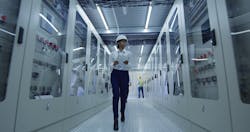Distribution system operators face a growing need for distributed energy resource situational awareness. One part of advanced distribution management system (ADMS) functionality that currently lacks adequate consideration is the modeling and management of distributed energy resources (DERs). At most utilities, monitoring and control of DERs from within the distribution control center typically is limited to monitoring metered outputs of large utility-scale energy resources and performing transfer tripping of these resources as backup protection against islanded operation. Most existing demand-response management systems (DRMS) and load management facilities can monitor some controllable loads; however, controllable load information is seldom provided to distribution system operators and ADMS applications that would benefit from having this information.
A stand-alone distributed energy resource management system (DERMS) provides services for managing grid level events, but it is not suitable for managing localized distribution system problems and optimizing the reliability, efficiency, and performance of individual substations and feeders. The latter capability is primarily the responsibility of the ADMS. Many of the ADMS applications require near-real-time information about the operating status and electrical outputs of DERs to accurately determine the distribution feeder electrical conditions and identify control strategies that may be used to avoid or mitigate the consequences of any operating problems. Most currently available ADMS solutions do not have enough near-real-time information about DER contributions to support these capabilities. For this reason, ESTA International LLC introduced a new concept — the DER-enabled ADMS — that combines the best features of DERMS and ADMS to differentiate it from the separate stand-alone systems.
DERMS Defined
DERs are nontraditional energy resources either connected directly to the distribution grid and owned by the distribution operator or connected behind the meter and owned by commercial, industrial, or residential customers. Nontraditional energy resources include generation powered by renewable sources (for example, solar power), customer cogeneration facilities, backup diesel generators, energy storage (including battery energy storage systems and electric vehicles with vehicle-to-grid capabilities) and controllable loads (demand response and load management, including electric vehicle chargers).
A DERMS provides centralized monitoring and control of DERs connected to a distribution grid by forecasting, monitoring and managing the operation of each DER to satisfy operating and business objectives. The DERMS also manages the operation of DERs based on directives from the grid control entity or regulatory body and handles compensation of DER asset owners for their participation in grid control events. To date, DERMS generally has been limited to managing demand-response (DR) facilities (that is, controllable loads). However, as the penetration level of distributed generation and distributed storage increases, DERMS also will need to manage these resources.
DERMS includes both technical and commercial functions.
Technical functions:
- Monitoring the current operating status and output of all DERs
- Forecasting future DER availability and output
- Broadcasting control commands/requests to participating DERs across the grid as required during grid events
- Verifying DERs have provided the expected response
Commercial functions:
- Registering new participants
- Managing customer opt-in and opt-out requests
- Handling incentive payments to customers.
To date, DERMS functionality most commonly has been implemented in a stand-alone system by third-party aggregators that specialize in the grid-level management of customer-owned assets. Aggregators enable owners of small-scale DERs that do not meet minimum asset size requirements to participate in regional power grid markets, such as frequency regulation and other ancillary services. Aggregators serve as a middleman between the end customer and grid market operator to insulate the customer from the complex rules of metering and verification and to handle incentive payments. With this approach, aggregators and distribution operators each need some level of DERMS functionality to manage the commercial and technical functionality of DERMS.
Impact of DERs
Currently, lack of DER awareness by the ADMS has not been a major problem because the DER penetration level — defined as total electrical capacity (MW or MWh) of the DERs as a percentage of the total energy consumption by the load — at many electric utilities is too small (<10%) to have a significant impact on distribution system electrical conditions. However, as the DER penetration level increases, the impact on distribution feeder electrical conditions can be significant.
Determining the DER penetration level at which significant operating problems can occur requires an engineering design analysis. As a rule of thumb, DERs may become a significant operating concern when the DER penetration level exceeds 30%. In addition, Federal Energy Regulatory Commission (FERC) Order 2222 requires electric distribution utilities to ensure the addition of DERs will not impact system reliability, power quality and safety.
Possible operating problems that may be experienced at higher DER penetration levels include but are not limited to the following:
- Load masking — Feeder load measurements available on the ADMS for the substation end of a feeder are actually net loads (actual customer load, supplied by DERs).
- Reverse power flow — If DER output (distributed generation output or energy storage discharging) on a feeder exceeds total feeder load (which may occur during lightly loaded conditions), reverse power flow (back toward the substation) can occur.
- Voltage reduction and excessive voltage regulator operation — Distributed generators with intermittent output level (such as solar photovoltaic generators on a partly cloudy day) can produce additional voltage regulation problems.
- Protection system coordination difficulties — High penetrations of distributed generators may produce a significant amount of fault current that can alter the coordination of feeder protection systems and distribution automation schemes, causing possible misoperation of these systems and unnecessary customer outages.
- Localized overloading due to electric vehicle (EV) chargers — Heavy EV charging activities can produce localized equipment overloading, especially at public charging stations and neighborhoods where clusters of EV chargers exist.
ADMS Shortcomings
The ADMS is a decision support system to assist distribution control room personnel with monitoring and control of the electric distribution system in an optimal manner while improving safety and asset protection. ADMS typically includes supervisory control and data acquisition (SCADA) facilities for distribution assets (such as transformers and switchgear), application software (such as on-line power flow and volt-VAR optimization) for near-real-time analysis and optimization of the distribution system and outage management functionality, plus interfaces to external systems such as geographic information systems and advanced metering infrastructure that furnish information required by the ADMS applications.
The current approach to monitoring and control of DERs by the ADMS typically is limited to near-real-time metering and transfer-tripping larger (utility-scale) generators that are required (by IEEE 1547) to disconnect during distribution line outages, to avoid islanded operation. Monitoring and control of other DERs (including smaller DERs such as rooftop solar generators, controllable loads and energy storage) usually is not implemented in the ADMS for the following reasons:
- Most DERs are customer owned and operated, and customers are not obligated (by standard connection agreements) to supply the utility with remote monitoring and control capability for these DERs.
- Adding remote monitoring and control facilities (including communication equipment) for many small-scale DERs is cost prohibitive for the utility, especially when the DERs are located on the customer side of the meter (behind the meter).
- ADMS has not been designed to handle the commercial aspects of DER management, such as registration of customers, verification of customer participation in system events and compensation for participating customers.
- Most DERs do not support communication protocols such as DNP3 that are commonly used by SCADA systems. Typically, DERs will support protocols and standards designed specifically for DER monitoring and management, such as OpenADR and IEEE 2030.5, and industrial standards like Modbus. Many other protocols (some proprietary in nature) may be used by smart appliances and other controllable loads located behind the meter.
The DER-Enabled ADMS
Incorporating detailed, real-time DER information in the ADMS electrical model improves situational awareness and ensures the electrical impacts of all types of DERs are accurately accounted for in the ADMS advanced applications. The table on the following page compares a stand-alone DERMS and stand-alone ADMS to the capabilities of a DER-enabled ADMS. There are three basic approaches to accomplish the DER-Enabled ADMS:
1. Add DERMS to an existing ADMS application suite. With this approach, the complete set of DERMS capabilities, including communication facilities to a very large number of customer-owned DERs, would be fully and seamlessly integrated as another application on the vendor’s standard ADMS suite of applications. This approach would be like incorporating outage management system (OMS) functions into the DMS product suite, which occurred a decade ago.
The benefits of this approach would be simplified and efficient access to DER models and information by the ADMS advanced application function as well as a similar user interface to all functions, providing a consistent look and feel for all applications used by the distribution operator. The downside of this approach would be a significant software development effort (with the associated risk), including adding the capability to communicate with potentially millions of customer-owned DERs. The result would be a product that is significantly less mature than existing DERMS products.
2. Add ADMS functionality to an existing DERMS application suite. With this approach, the complete set of ADMS application functions (including the electrical model) would be added to an existing DERMS product. The benefits of this approach, a fully integrated product suite, would be the same as those mentioned in the first approach. This approach would also have a similar downside; a significant and risky development effort would be required that could result in immature ADMS functionality.
3. Interface a separate DERMS to the ADMS, a bolt-on solution. This approach would interface an ADMS from an established ADMS vendor with a DERMS system from an established DERMS supplier. This interface would enable the ADMS to receive DER information and initiate DER control actions when needed. The DERMS would handle the functionality it was designed for, including communicating with potentially millions of DERs and handling the commercial aspects of DERMS, such as customer registration and incentive payments. The ADMS applications would benefit from having detailed information about DERs, such as DER status and output as well as forecast capabilities, which would be included in the ADMS electrical model.
The Right Fit
DERMS solutions are available from vendors specializing in only DERMS software as well as from vendors specializing in ADMS software. The decision to implement a stand-alone DERMS or a DER-enabled ADMS will depend on the owner and manager of the DERs and use cases that must be supported by the DERMS.
Distribution operators with an existing ADMS could consider adding DERMS functionality as part of the overall single-vendor software implementation, but there may be challenges in a seamless upgrade path and with the cost and effort to upgrade the existing ADMS.
Furthermore, DERMS may not support the required commercial functionality. While it may seem like an easy path to upgrade or keep to a single-vendor solution, distribution operators should follow the needs analysis, stakeholder buy-in, design, specification and procurements steps with a sole-source procurement as they would with a new or upgraded ADMS.
A distribution operator may not initially place much emphasis on the commercial aspect of a DERMS but may later decide to also be a DER aggregator to participate in the wholesale energy market. In that case, the distribution operator should consider an upgrade path to include the capability to future-proof the DERMS by including both technical and commercial functions. A separate bolt-on DERMS for the distribution operator might be a better choice because it would be easier to modify and upgrade while the DERMS landscape is still maturing.
The distribution grid will continue to become more complex as the number of DERs and microgrids increase, with a continued need for the distribution grid to become more proactive in handling changing operating conditions while ensuring reliability and quality of service to customers. The DER-enabled ADMS will likely play an increasingly important role in the management of the distribution grid of the future.
Robert “Bob” Uluski ([email protected]) is an executive consultant with ESTA International LLC consulting. He has over 40 years of experience in electric utility T&D automation systems. His experience includes planning and implementing energy storage, microgrid control systems, advanced distribution management systems, feeder automation systems, substation automation, protective relay systems, and distributed energy resource management systems (DERMS). Uluski has helped numerous North American and international electric utilities to plan, design, and implement computer and communication systems for automating distribution feeders and substations, along with DMS and enterprise level systems that make optimal use of these automation facilities. He has served as chair and vice chair of several IEEE Power and Energy Society working groups and task forces and also is a member of the DistribuTECH Advisory Committee. In 2010, the IEEE PES awarded Uluski the Douglas M. Staszesky Distribution Automation award in recognition of his contribution to the deployment of distribution automation in the utility industry. He received his BSEE degree from Northeastern University and MSEE degree from the University of Wisconsin. He is a senior member of the IEEE and a registered professional engineer.
Stuart Borlase ([email protected]) is a principal consultant with ESTA International LLC consulting. He has over 25 years of experience in the modernization and business transformation of utility, energy and industrial markets. His experience includes smart grid, grid real-time monitoring and control, substation and distribution automation, protective relaying systems, microgrid control systems, distributed energy resource management systems (DERMS), IEC 61850, digital substations, North American Electric Reliability Corporation compliance, IT/OT integration, and device and asset management. He previously worked for Schneider Electric, Siemens, Wipro Technologies, and General Electric. Borlase received his M.Eng. and D.Eng. in electrical engineering from Texas A&M University. He is a senior member of the IEEE, a registered professional engineer, and a certified Six Sigma Black Belt.
About the Author
Stuart Borlase
Stuart Borlase ([email protected]) is a principal consultant with ESTA International LLC consulting. He has over 25 years of experience in the modernization and business transformation of utility, energy and industrial markets. His experience includes smart grid, grid real-time monitoring and control, substation and distribution automation, protective relaying systems, microgrid control systems, distributed energy resource management systems (DERMS), IEC 61850, digital substations, North American Electric Reliability Corporation compliance, IT/OT integration, and device and asset management. He previously worked for Schneider Electric, Siemens, Wipro Technologies, and General Electric. Borlase received his MSEE degree and doctorate degree in electrical engineering from Texas A&M University. He is a senior member of the IEEE, a registered professional engineer, and a certified Six Sigma Black Belt.
Robert Uluski
Robert “Bob” Uluski ([email protected]) is an executive consultant with ESTA International LLC consulting. He has over 40 years of experience in electric utility T&D automation systems. His experience includes planning and implementing energy storage, microgrid control systems, advanced distribution management systems, feeder automation systems, substation automation, protective relay systems, and distributed resource energy management systems (DERMS). Uluski has helped numerous North American and international electric utilities to plan, design, and implement computer and communication systems for automating distribution feeders and T&D substations, along with DMS and enterprise level systems that make optimal use of these automation facilities. He has served as chair and vice chair of several IEEE Power and Energy Society (PES) working groups and task forces and also is a member of the DistribuTECH Advisory Committee. In 2010, the IEEE PES Uluski the Douglas M. Staszesky Distribution Automation award in recognition of his significant contribution to the deployment of distribution automation in the electric utility industry. He received his BSEE degree from Northeastern University and MSEE degree from the University of Wisconsin. He is a senior member of the IEEE and a registered professional engineer.



